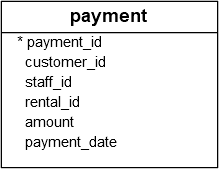PostgreSQL GROUP BY
Summary: in this tutorial, you will learn how to use PostgreSQL GROUP BY clause to divide rows into groups.
Introduction to PostgreSQL GROUP BY clause
The GROUP BY clause divides the rows returned from the SELECT statement into groups.
For each group, you can apply an aggregate function such as SUM() to calculate the sum of items or COUNT() to get the number of items in the groups.
The following illustrates the basic syntax of the GROUP BY clause:
SELECT
column_1,
column_2,
...,
aggregate_function(column_3)
FROM
table_name
GROUP BY
column_1,
column_2,
...;In this syntax:
- First, select the columns that you want to group such as
column1andcolumn2, and column that you want to apply an aggregate function (column3). - Second, list the columns that you want to group in the
GROUP BYclause.
The GROUP BY clause divides the rows by the values in the columns specified in the GROUP BY clause and calculates a value for each group.
It’s possible to use other clauses of the SELECT statement with the GROUP BY clause.
PostgreSQL evaluates the GROUP BY clause after the FROM and WHERE clauses and before the HAVING SELECT, DISTINCT, ORDER BY and LIMIT clauses.

PostgreSQL GROUP BY clause examples
Let’s take a look at the payment table in the sample database.

1) Using PostgreSQL GROUP BY without an aggregate function example
The following example uses the GROUP BY clause to retrieve the customer_id from the payment table:
SELECT
customer_id
FROM
payment
GROUP BY
customer_id
ORDER BY
customer_id;Output:
customer_id
-------------
1
2
3
4
5
6
7
8
...Each customer has one or more payments. The GROUP BY clause removes duplicate values in the customer_id column and returns distinct customer ids. In this example, the GROUP BY clause works like the DISTINCT operator.
2) Using PostgreSQL GROUP BY with SUM() function example
The GROUP BY clause is useful when used in conjunction with an aggregate function.
The following query uses the GROUP BY clause to retrieve the total payment paid by each customer:
SELECT
customer_id,
SUM (amount)
FROM
payment
GROUP BY
customer_id
ORDER BY
customer_id;Output:
customer_id | sum
-------------+--------
1 | 114.70
2 | 123.74
3 | 130.76
4 | 81.78
5 | 134.65
6 | 84.75
7 | 130.72
...In this example, the GROUP BY clause groups the payments by the customer id. For each group, it calculates the total payment.
The following statement uses the ORDER BY clause with GROUP BY clause to sort the groups by total payments:
SELECT
customer_id,
SUM (amount)
FROM
payment
GROUP BY
customer_id
ORDER BY
SUM (amount) DESC;Output:
customer_id | sum
-------------+--------
148 | 211.55
526 | 208.58
178 | 194.61
137 | 191.62
144 | 189.603) Using PostgreSQL GROUP BY clause with the JOIN clause
The following statement uses the GROUP BY clause to retrieve the total payment for each customer and display the customer name and amount:
SELECT
first_name || ' ' || last_name full_name,
SUM (amount) amount
FROM
payment
INNER JOIN customer USING (customer_id)
GROUP BY
full_name
ORDER BY
amount DESC;Output:
full_name | amount
-----------------------+--------
Eleanor Hunt | 211.55
Karl Seal | 208.58
Marion Snyder | 194.61
Rhonda Kennedy | 191.62
Clara Shaw | 189.60
...In this example, we join the payment table with the customer table using an inner join to get the customer names and group customers by their names.
4) Using PostgreSQL GROUP BY with COUNT() function example
The following example uses the GROUP BY clause with the COUNT() function to count the number of payments processed by each staff:
SELECT
staff_id,
COUNT (payment_id)
FROM
payment
GROUP BY
staff_id;Output:
staff_id | count
----------+-------
1 | 7292
2 | 7304
(2 rows)In this example, the GROUP BY clause divides the rows in the payment table into groups and groups them by value in the staff_id column. For each group, it counts the number of rows using the COUNT() function.
5) Using PostgreSQL GROUP BY with multiple columns
The following example uses a GROUP BY clause to group rows by values in two columns:
SELECT
customer_id,
staff_id,
SUM(amount)
FROM
payment
GROUP BY
staff_id,
customer_id
ORDER BY
customer_id;Output:
customer_id | staff_id | sum
-------------+----------+--------
1 | 2 | 53.85
1 | 1 | 60.85
2 | 2 | 67.88
2 | 1 | 55.86
3 | 1 | 59.88
...In this example, the GROUP BY clause divides the rows in the payment table by the values in the customer_id and staff_id columns. For each group of (customer_id, staff_id), the SUM() calculates the total amount.
6) Using PostgreSQL GROUP BY clause with a date column
The following example uses the GROUP BY clause to group the payments by payment date:
SELECT
payment_date::date payment_date,
SUM(amount) sum
FROM
payment
GROUP BY
payment_date::date
ORDER BY
payment_date DESC;Output:
payment_date | sum
--------------+---------
2007-05-14 | 514.18
2007-04-30 | 5723.89
2007-04-29 | 2717.60
2007-04-28 | 2622.73
...Since the values in the payment_date column are timestamps, we cast them to date values using the cast operator ::.
Summary
- Use the PostgreSQL
GROUP BYclause to divide rows into groups and apply an aggregate function to each group.